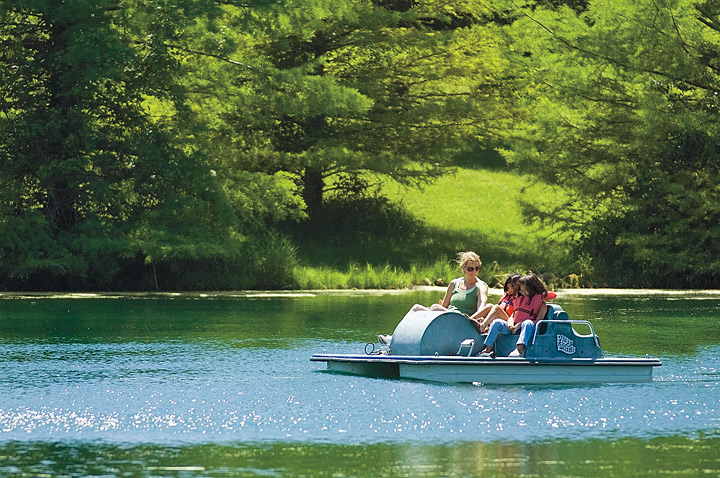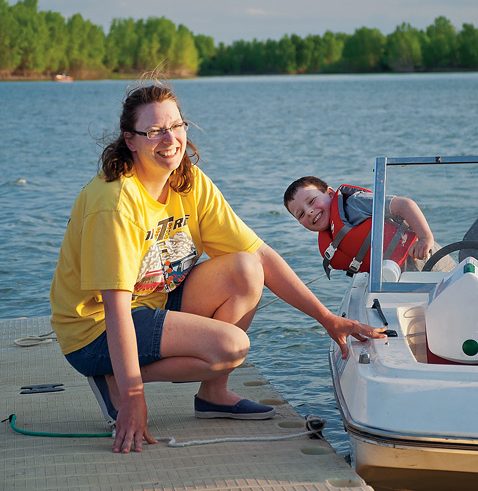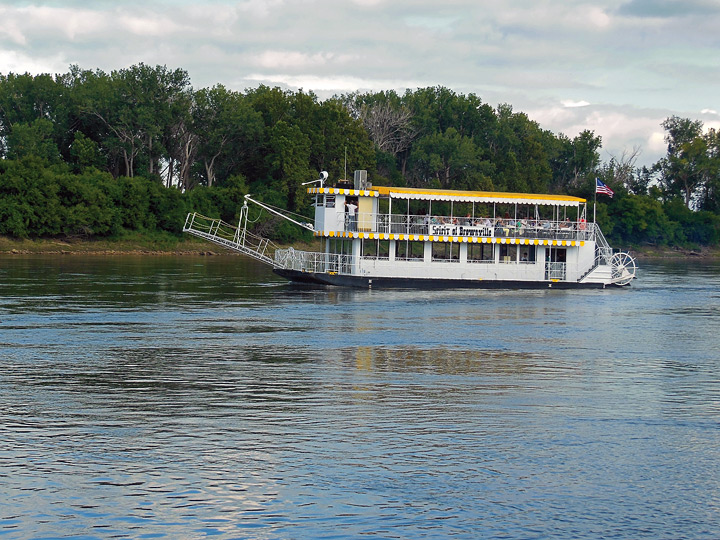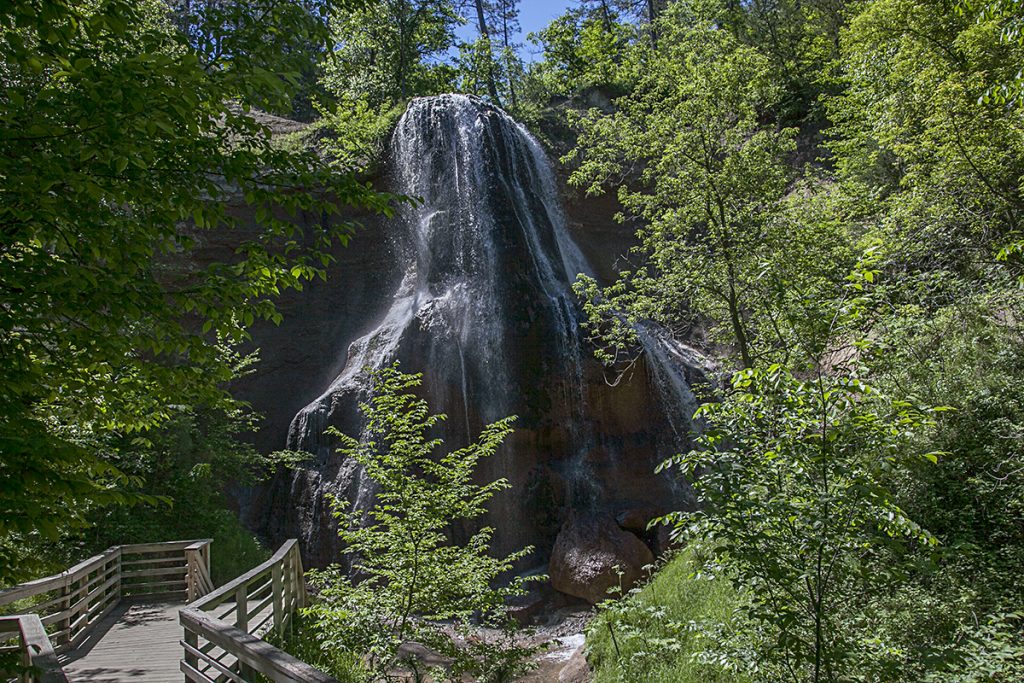 Berry Falls near Valentine. Photo by Barbara Johnston.
Berry Falls near Valentine. Photo by Barbara Johnston. Nebraska is blessed with water. The same water bringing life to our crop fields and sea of prairie grass provides an ocean of recreational opportunities thanks to man-made reservoirs, natural Sandhills lakes and shallow spring-fed rivers.
Adventure is just offshore for those not skittish about leaving the land. Float, ride and wade along with us in this immersive exploration of Nebraska’s aquatic adventures.
- Kayaking and tanking
Kayaking and tanking are two of the fastest growing water activities in our state. While kayaks are mostly one- and sometimes two-person craft, tanks allow entire groups of friends to float together.
What is tanking? Well, it has nothing to do with the military. The idea was born decades ago, possibly in the Nebraska Sandhills after a storm blew a livestock tank into a pond and a rancher saw it floating.
These stable craft do not steer easily. Trade paddles for a pole for pushing away from the bank, logs and sandbars. Mother Nature does the rest of the work, except when shallow water compels the tank’s occupants to drag it for short stretches.
Several Nebraska outfitters rent tanks, shuttle riders and tanks upstream and pick them up later downriver. Riders sit in chairs, on built-in benches or on a picnic table in the tank – each perfect for a floating picnic lunch. Here’s a tip for a tasty tanking treat: Bring a watermelon. They travel well and are a refreshing snack that can simply be cracked open on the riverbank. Another tip: Don’t be a melon head and forget the sunscreen. Plastic kayaks are all the watery rage these days. Sit-on-top and sit-inside models are easily strapped to the top of anything other than a motorcycle or airplane and are easily carried with one hand. Kayaks vary from simple shells with a molded seat, to fancier models with adjustable seats and foot pegs with sealed compartments for keeping valuables dry. Sit-in types are most popular, but sit-on-top kayaks are gaining ground, err, water. Both are highly maneuverable and simple for paddlers of any age to learn.
Patty Geist lives on the north channel of the Platte River near Kearney. Her wirehaired pointing griffon, Thelma, balances on the front of her kayak during paddling trips near home.
“I kayaked with friends once and was hooked,” Geist said. “The experience can be social with friends, or a quiet interaction with nature on a solo trip. I’ve been fortunate to have deer swim in front of me, hear the trill of cranes overhead, observe river otters frolic, and play tag with a heron – all while paddling my kayak.
“The Platte River has its own unique allure. If you’re planning to paddle instead of drag your kayak you need to check the water flow first. The Platte River doesn’t adapt to your vacation or schedule, and it is a different adventure each time you push off.”
2. Tubing
Inner tubes were the first vessels for many Nebraskan aquatic adventurers. Long before flashy, colored “tubes” with bright graphics, cup holders and handles made the scene, tractor-tire inner tubes were the craft of convenience since most farms had a few hanging from the rafters in the barn. Children riding bicycles to the nearest filling station with deflated inner tubes slung over their shoulders is a common summer sight. Whether the dusty and already patched inner tube leaks or holds determines who floats the creek with the rest of the gang.
At places like Long Pine Creek in Brown County, riders on those old standards float alongside tourists on bright yellow and red tubes. Some are built to haul coolers. Others are so large that they barely fit between the banks of the narrow, cool stream. It’s a short float, and adventurers are often seen walking through Hidden Paradise upstream to launch again and again.
Creeks and rivers are prime places for “tubing.” While many never outgrow their inner tube roots, for others, those simple floaters are gateway craft to higher adventure.
3. Canoeing
It’s hard to beat a canoe for floatable fun. The simple design developed in ancient times is effective for cutting through water.Popular fiberglass and aluminum models are much lighter than a hollowed-out cottonwood. They can take a beating, too. A barbed wire-scraped, dented and dulled canoe is a status symbol among river people – a sure sign that the paddler is no fair-weather floater. Though canoeing is manageable alone, a team of two paddlers, one in the bow (front) and one at the stern (back), makes for an enjoyable venture if teamwork is employed. It only takes a few minutes to get the hang of pushing or pulling the paddle through the water to maneuver the craft.
After flipping one too many times, Tim Capps of North Loup made outriggers and bolted them to his aluminum canoe. Now he stands in it while fishing.
“Motorboats are nice but so is getting back to basics in a canoe,” Capps said. “I’ll never be without mine.”
The many barbed wire fences crossing our rivers challenge novice paddlers. Skilled canoeists have learned to lean forward, lift the bottom wire with their paddle, set it on the canoe’s gunwales while floating under and hunkering down as the wire slides just over them. Currents do much of the work on rivers. A canoe’s sleek shape makes paddling to favorite fishing spots or sheltered coves on lakes a breeze.
4. Sailing
If the wind is right you can sail away and find tranquility sailing on Nebraska lakes. The Lincoln Snipe Fleet floats their sailboats on Branched Oak Lake near Lincoln, and the group’s motto is “Serious sailing. Serious fun.” Mike Kuhl is vice commodore for the fun group that’s hosted the annual Firewater Regatta for 48 years.
“You don’t need an ocean to enjoy sailing,” Kuhl said. “Nebraska offers some of the finest conditions for our sport due to our nearly consistent winds and public waterways. Whether it’s big lake cruising or plodding around a city pond, sailing is one of the best ways to harness all that the Nebraska summer has to offer.”
Kuhl sails a Hobie 16 catamaran and a Catalina 25 at Branched Oak, a Laser Class dinghy on lakes in Lincoln and a 26-foot cruiser at Lewis and Clark Lake. He enjoys the social aspects of sail boating and the generosity of the sailing community.
“You don’t even need to buy a boat,” Kuhl said. “Sailing is best enjoyed with others, and any sailor I know would be glad to welcome new members onboard. I’ve made some of my best friends in life through the sailing community right here in Nebraska.”
5. Paddleboarding and paddleboats
We wouldn’t blame you for doing a double take near one of Omaha’s many lakes. No, it’s not a woman walking on water. The holy floater is Alma Royster, and she’s paddling while standing on a king-size surfboard. She’s introduced hundreds to the joys of stand up paddleboarding (SUP) during 3-hour lessons through her business, Meander SUP. “They have to put away their iPhones and disconnect from Facebook for three hours,” Royster said.
There’s a strong flotilla of paddleboarders in the Metro. With ample farm ponds, Sandhills lakes and gentle rivers across Nebraska, these paddle-powered prairie schooners may soon float statewide.
For those with residential and farm ponds, paddleboats are a fun accessory. If you can pedal a bike you can pedal a paddleboat. You can try it at Mahoney or Platte River state parks in the east, Victoria Springs State Recreation Area near Anselmo and Chadron State Park in the west. Several other public areas have the boats for rent on a first-come, first-serve basis.
6. Gondola rides
Visions of Venice reflect off the lake in Omaha’s Heartland of America Park when gondolier Steve Anderson rows his classic boat slowly past its arching fountains. He started Heartland Gondolas in 2002. “There were gondolas in Omaha during the Trans Mississippi Exposition in 1898,” Anderson said. “I thought it would be fun to bring them back, and it is fun.”
Couples and families alike climb aboard in the Old Market before rowing to ConAgra Lagoon and back during 15-30 minute cruises from May to September.
More than 150 wedding engagements have taken place on his gondola. “There’s no need to travel to Italy for a romantic gondola ride,” Anderson said. “You can do it right here in Omaha, and besides, the water is cleaner here than it is in Venice.”
7. Airboating
Silence sinks when airboats rise to skim across our shallow rivers. These noisy boats associated with southern swamps were invented in Canada in 1905. Telephone inventor Alexander Graham Bell tested various engines and propellers on the first airboat, The Ugly Duckling. Bell’s employee and friend, early aviation pioneer Glenn Curtiss, also was involved in the development of these shallow water craft that skim across the water and often are equipped with airplane engines.
Airboat enthusiasts congregate along the Loup River near St. Paul, Palmer, Fullerton and Genoa; on the Platte near Fremont, Central City and Grand Island; and along the Elkhorn near Norfolk and Scribner. Airboat clubs host poker runs, catfish cookouts and morel mushroom hunts up and down their riverine haunts.
The noise drains as massive motors slow and cease as self-proclaimed river rats stop to cast stinky baits into murky catfish holes. Children spill out to stretch their legs, swim or chase frogs.
“Airboats can go places most people will never see,” said Doug Manske of rural Ashland. “We beach ours on a sandbar, unpack our lunches and let the kids explore. I think everyone should get to do this.”
8. Scuba diving
“Nebraska has a surprising number of scuba divers for a land-locked state,” said Paige Purdy of Kearney. She’s dived worldwide but encountered the strangest things while diving in Central Nebraska. Her business, Heartland Scuba Center of Kearney, has trained more than 1,000 Nebraskans to scuba dive and hosts dive classes south of Elm Creek at Sandy Channel State Recreation Area. Below the surface divers have placed statues of gargoyles, an alligator, a 300-pound turtle, a 5-foot-long hippopotamus wearing scuba tanks and other items anglers have been snagging their lines on for years. “We’ve made it a playground for divers,” said Purdy, who just returned from dive trips in Panama and Bonaire.
She also dives at Calamus and Elwood reservoirs and other sandpit lakes. “Some of the best walleye spearfishing around can be found at Lake McConaughy,” she said.
“It’s so peaceful just hearing the rhythm of your own breath as you swim along and see amazing creatures whether you’re in Nebraska or the Caribbean,” said Keely Montgomery of Omaha. She swam competitively in high school and followed the flow to a job with DiVentures of Omaha, where she works now. The company trains divers at a quarry in southeast Nebraska. “There’s a big rock wall there where you swim along and see crevices where fish live,” Montgomery said. “The bluegill there are so friendly – they follow the divers hoping they’ve brought snacks for them.”
9. Motorboating
The motoring fun continues with pontoon and motorboats cruising, pulling water skiers and wakeboards and ferrying fishermen on the Missouri River and irrigation reservoirs across the state. They range from jon boats with small pull-start outboards to tri-hull and V-bottom models with multiple motors. Our larger lakes are home to luxurious yachts with huge inboard motors and living quarters, and scooter-like personal watercraft can be enjoyed on all but the smallest lakes.
In the mid-1800s a dozen steamboats a day docked at Brownville. The coming of the railroad drained the steamer business from the area. Randel and Jane Smith filled the void when they launched their Spirit of Brownville riverboat in 1981.
The 150-passenger Spirit fills for dinner cruises, group charters and sightseeing tours. It ties up to the River Inn, a floating luxury resort the Randels bought from a casino upriver in 2003, gutted and opened as a luxury bed and breakfast in 2009.
“We float along with a glass of wine, and the river is so broad and peaceful,” said Nancy Lee Moran of Auburn, who rides the Spirit of Brownville with her husband, Bill. “Even on the hottest days there’s a breeze on the river.”
10. Waterfall adventures
While we often pray for rain, water falls from the sky everyday on the Niobrara River. Waterfalls like Smith Falls, our state’s tallest where water cascades 63 feet to the floor of the Niobrara River Valley, are well known. There are more than 200 others on the Snake and Niobrara rivers in Nebraska.
Smith Falls State Park was established in 1992. The 250-acre park near Sparks includes canoe landings, campgrounds, picnic areas, restrooms and showers. A river trail and footbridge over the Niobrara River guides visitors to a boardwalk and then the waterfall. Visitors pose for photos, frolic and cool off in summer under the stinging yet refreshing spring-fed spray. The lesser-known and much smaller Turkey Feather Falls also is here. A slightly more strenuous hike leads visitors to Fort Niobrara National Wildlife Refuge east of Valentine to Fort Falls. Other curiosities here include herds of elk and bison, a prairie dog town and the two-tiered Stinard Falls.
Whether you’re floating gracefully on top, wading knee-deep or are totally submerged, opportunities for aquatic fun in Nebraska are as vast as the resource itself. The simple pleasure of standing under a Niobrara River waterfall, wading along your favorite beach, taking a dip in a farm pond or just dipping a toe in from the dock is always just a splash away.










Join the Discussion
No comments